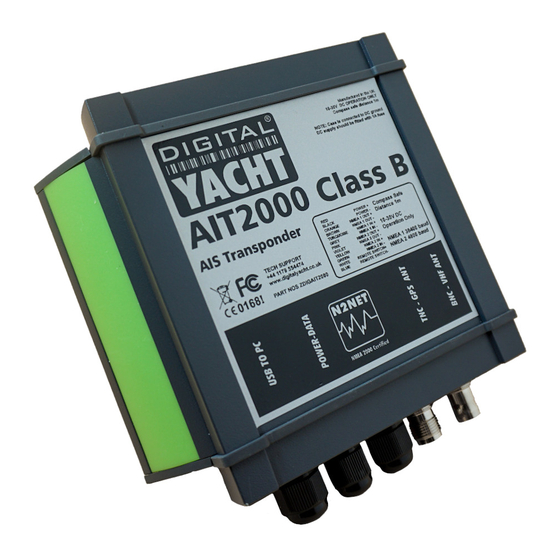
DIGITAL YACHT AIT2000 Technical Notes
Hide thumbs
Also See for AIT2000:
- Installation & operation manual (29 pages) ,
- Product handbook (28 pages) ,
- Installation and instruction manual (8 pages)
Table of Contents
Advertisement
Quick Links
Article Number - 00011-2012
Date -
Article applies to – AIT2000 AIS Transponders
ISSUE:
Fault Finding an AIT2000 Class B Transponder
Once an AIT2000 has been installed and operating correctly for some time, the most common causes of failure
are the external connections i.e. Power, VHF antenna and GPS Antenna.
Testing the Power Supply Connections
If, when you apply power to the transponder by turning on the circuit breaker or switch, you get no LEDs light
up, then you most likely have a power connection problem. Make sure that any circuit breakers or fuses in the
power supply circuit are OK and then measure the voltage across the Red (+) and Black (-) wires on the
transponders power/data cable. If there is not a good supply voltage present of between 11v and 14.5v then
you have a wiring problem.
If the supply voltage is good, it is worth remaking the red and black wire power connections to the AIT2000 as
the crimp or terminal block connections on these small gauge wires can be difficult to make and, if poorly
made with the wrong gauge connector, can often be less reliable than larger gauge wire connections.
The AIT2000 will power up in receive only mode, when plugged in to a computer's USB socket, with no
external power applied. If the unit is failing to power up from the external power supply connections, try
plugging the USB lead in to a PC and see if the AIT2000 powers up – red and yellow LEDs should light.
If the power connections are all OK, the transponder will start its power up sequence during which the LEDs
should light as follows;
1) Green LED will come on briefly.
2) All four LEDs should flash once.
3) Just the Yellow LED should illuminate.
4) The yellow LED will stay on until the GPS gets its first fix and the transponder transmits its first AIS
position report. At this point (usually within a few minutes of power up) the yellow LED will go OFF and
the green LED will come ON.
5) The green LED will now stay on for the majority of the time and indicates that everything is OK and that
the transponder is transmitting and receiving correctly. You may occasionally see the yellow LED come
ON if the transponder tries to transmit but another vessel has taken its time slot or the GPS position is
temporarily lost, but this is the exception and for >90% of the time the green LED should be the only
LED illuminated.
th
15
June 2012
Advertisement
Table of Contents

Summary of Contents for DIGITAL YACHT AIT2000
- Page 1 If the unit is failing to power up from the external power supply connections, try plugging the USB lead in to a PC and see if the AIT2000 powers up – red and yellow LEDs should light.
- Page 2 Alarms. The following screen shot is taken from proAIS2 connected to an AIT2000 that is working correctly. Note the five green ticks that indicate the results of five key status checks.
- Page 3 The image on the right (above) was actually taken with no antenna connected. If you are still seeing a screen like this after the AIT2000 has been on for a few minutes, then the GPS inside the AIT2000 may have a fault or the GPS antenna/cable may be defective.
- Page 4 AIT2000 must be at fault and will need to be returned to Digital Yacht for repair. If the power supply is good and the GPS is working correctly, but the AIT2000 is not transmitting (RED or RED and YELLOW light on continuously) then there maybe a problem with the AIS/VHF antenna. If you are using a splitter to connect the boat’s existing VHF antenna to the transponder, ensure that the splitter is definitely...
- Page 5 – perhaps using a spare emergency VHF antenna. If the new antenna gives the same high VSWR readings then you have to assume that the AIT2000 is at fault but more often than not it is the antenna or installation that is at fault in these high VSWR situations.






Need help?
Do you have a question about the AIT2000 and is the answer not in the manual?
Questions and answers